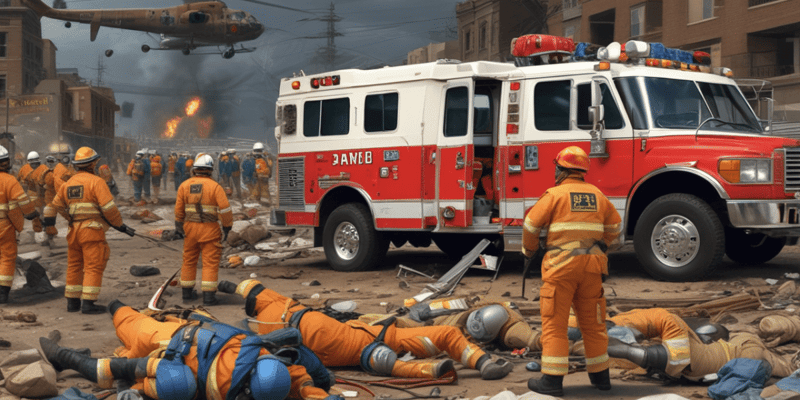Podcast Beta
Questions and Answers
What should be the primary focus during the triage process?
In the SALT triage method, what does the category 'GRAY' signify?
What is the order of treatment or transport according to the triage guidelines?
What role do officers play when assisting in a multiple agency response to a mass casualty incident?
Signup and view all the answers
What does the acronym SALT stand for in relation to triage?
Signup and view all the answers
What is the initial action taken during the triage phase?
Signup and view all the answers
What system is implemented in Florida for handling multiple agency responses?
Signup and view all the answers
Which category indicates a patient who has sustained minor injuries and can wait for treatment?
Signup and view all the answers
What is the primary goal of triage during a mass casualty incident?
Signup and view all the answers
What should be the first step of a first responder upon arriving at a mass casualty incident?
Signup and view all the answers
Which of the following correctly describes the START method of triage?
Signup and view all the answers
During an MCI, what should a first responder do with walking wounded individuals?
Signup and view all the answers
What is a critical initial task for the first officer at a mass casualty incident?
Signup and view all the answers
What does the phrase 'do the most for the most' refer to in the context of triage?
Signup and view all the answers
What should be the priority for a first responder when there are multiple patients with severe injuries?
Signup and view all the answers
In the context of a mass casualty incident, what does BSI stand for?
Signup and view all the answers
What is the first action to take when addressing patients who can hear your voice and can walk?
Signup and view all the answers
In START triage, which color tag indicates a deceased patient?
Signup and view all the answers
What should you do if a patient's respiratory rate exceeds 30 breaths per minute?
Signup and view all the answers
How should perfusion be assessed during triage?
Signup and view all the answers
If a patient does not follow simple commands during mental status assessment, what tag should they receive?
Signup and view all the answers
Which mnemonic helps remember the assessment priorities during triage?
Signup and view all the answers
What action should be taken with a patient who is still not breathing after clearing the airway?
Signup and view all the answers
What should be prioritized while making triage decisions in cases of borderline assessment?
Signup and view all the answers
Study Notes
Lesson Goal
- Respond effectively as the first officer to a mass casualty incident (MCI).
- Handle incidents with multiple casualties, such as traffic crashes, severe weather, and active threat situations.
First Officer Role
- Conduct a scene size-up and establish command upon arrival.
- Communicate with other first responders and dispatch simultaneously.
- Prioritize and assess patients based on the severity of injuries before administering first aid.
Triage Process
- Triage is sorting and categorizing patients to allocate medical attention effectively.
- Aim to achieve 'the most for the most' rather than extensive treatment for a single patient.
- Initial interventions, like tourniquet application, can be performed while assessing all patients quickly.
- Follow local protocols and department policies concerning triage models.
START Triage Method
- Simple Triage and Rapid Treatment (START) is effective for rapid assessment by minimally trained personnel.
- Steps:
- Use BSI and appropriate Personal Protective Equipment (PPE).
- Gather all walking wounded in one safer location.
- Triage and tag injured patients using color-coded ribbons.
- Color Codes:
- RED: Immediate attention required
- YELLOW: Delayed attention
- GREEN: Minor injuries (ambulatory)
- BLACK: Deceased (non-salvageable)
- Use the RPM mnemonic for assessment:
- Respiration: Check breathing rate, tag RED if >30 breaths/min, BLACK if not breathing.
- Perfusion: Assess radial pulse; no pulse or slow capillary refill means tag RED.
- Mental Status: Evaluate command-following; send those following commands to YELLOW, others to RED.
SALT Triage Method
- Sort, Assess, Life-Saving Interventions, Treatment/Transport (SALT) incorporates additional categories.
- Categories:
- RED: Immediate
- GRAY: Expectant (likely to die)
- YELLOW: Delayed
- GREEN: Minimal
- BLACK: Deceased
- Focus initially on the most critical patients, ensuring immediate treatment and transport.
Multiple Agency Response
- As an officer, your role may vary based on arrival time and local protocols (ICS implementation in Florida).
- The incident commander may relinquish control, providing a situation report if needed.
- Effective command and triage by the first officer alleviates scene stress and enhances the overall response efficiency.
Studying That Suits You
Use AI to generate personalized quizzes and flashcards to suit your learning preferences.
Related Documents
Description
This quiz assesses your knowledge and skills as a first officer responding to mass casualty incidents (MCI). You will be tested on scene size-up, triage processes, and effective communication in high-pressure situations. Mastery of the START triage method is essential for prioritizing patient care during emergencies.




